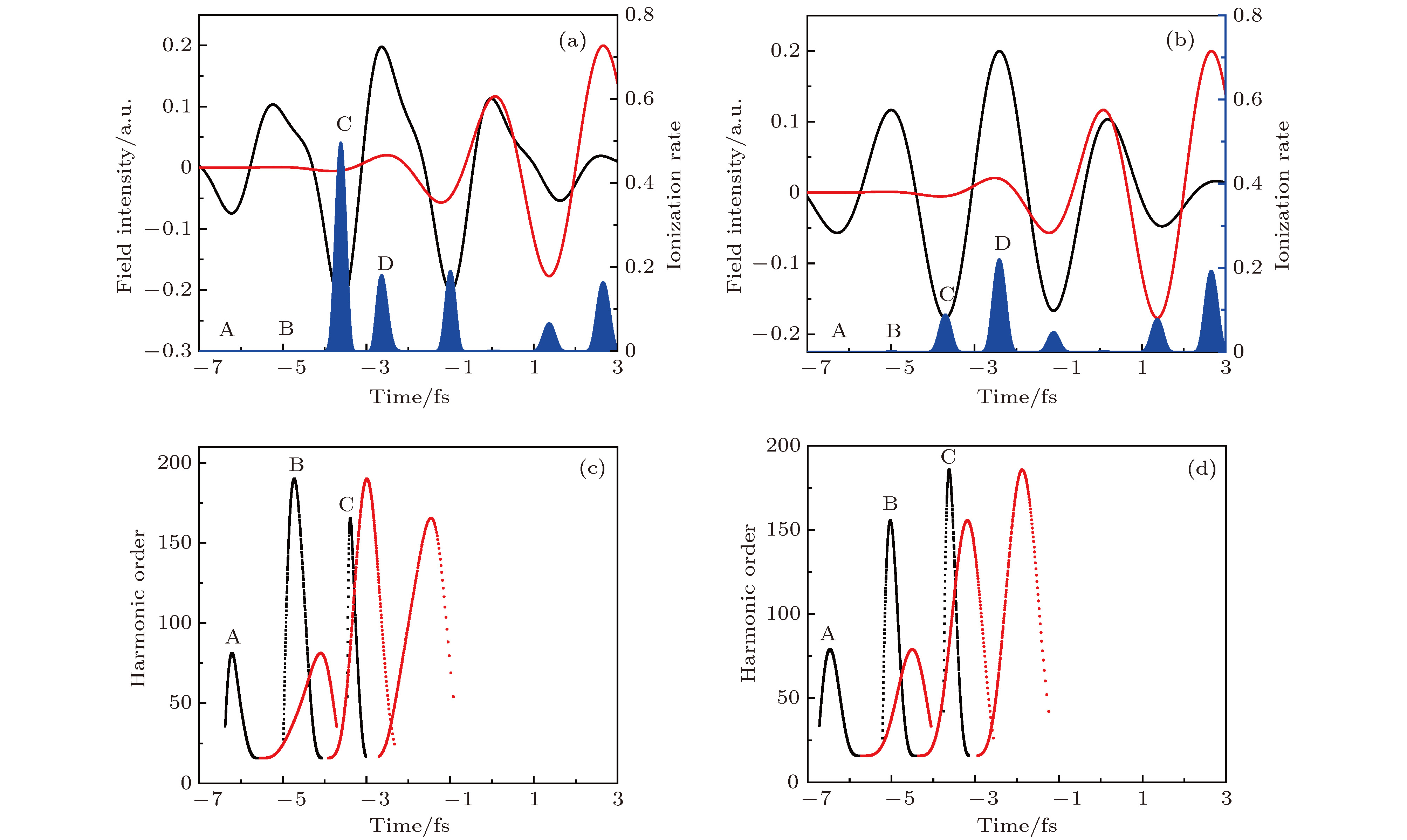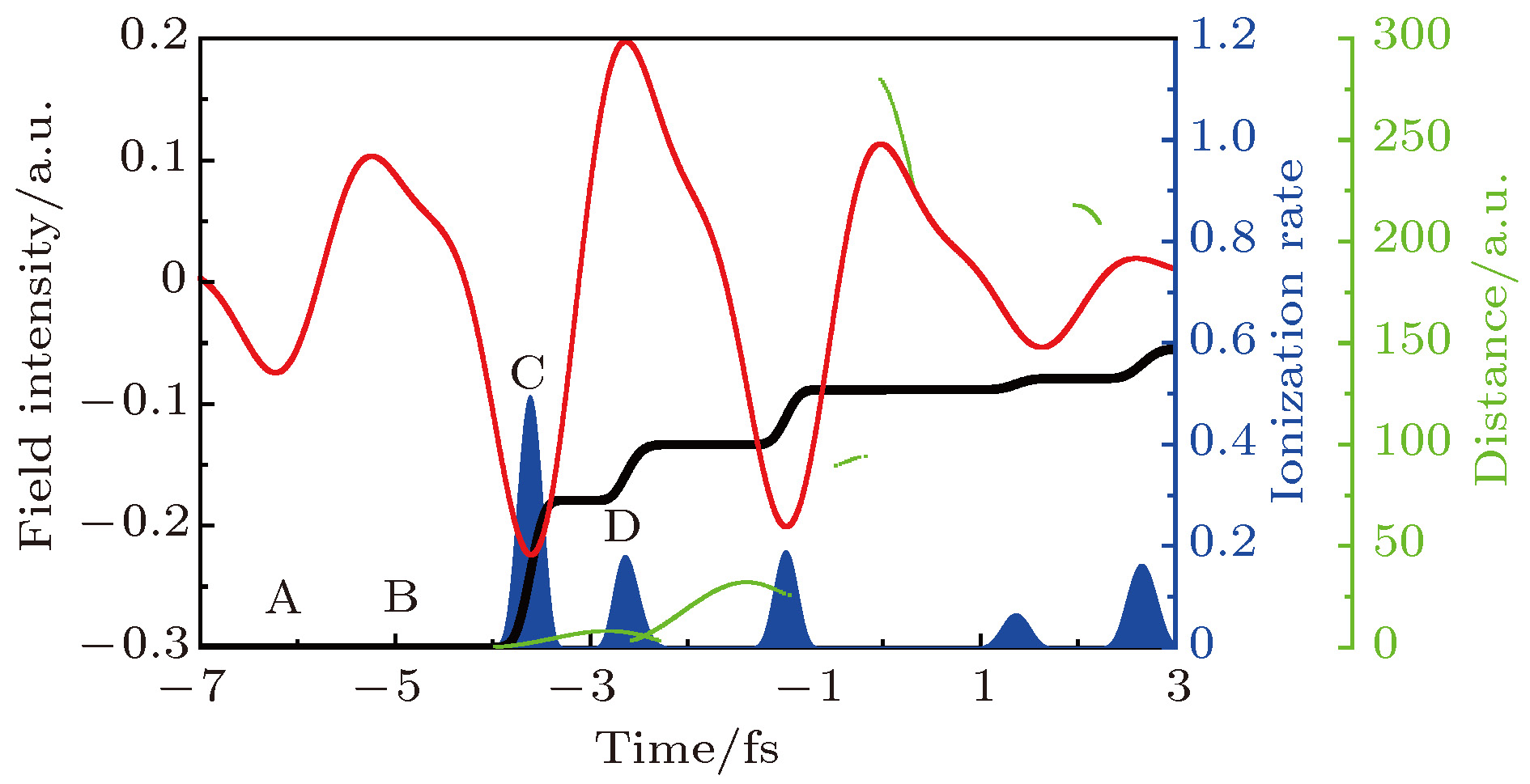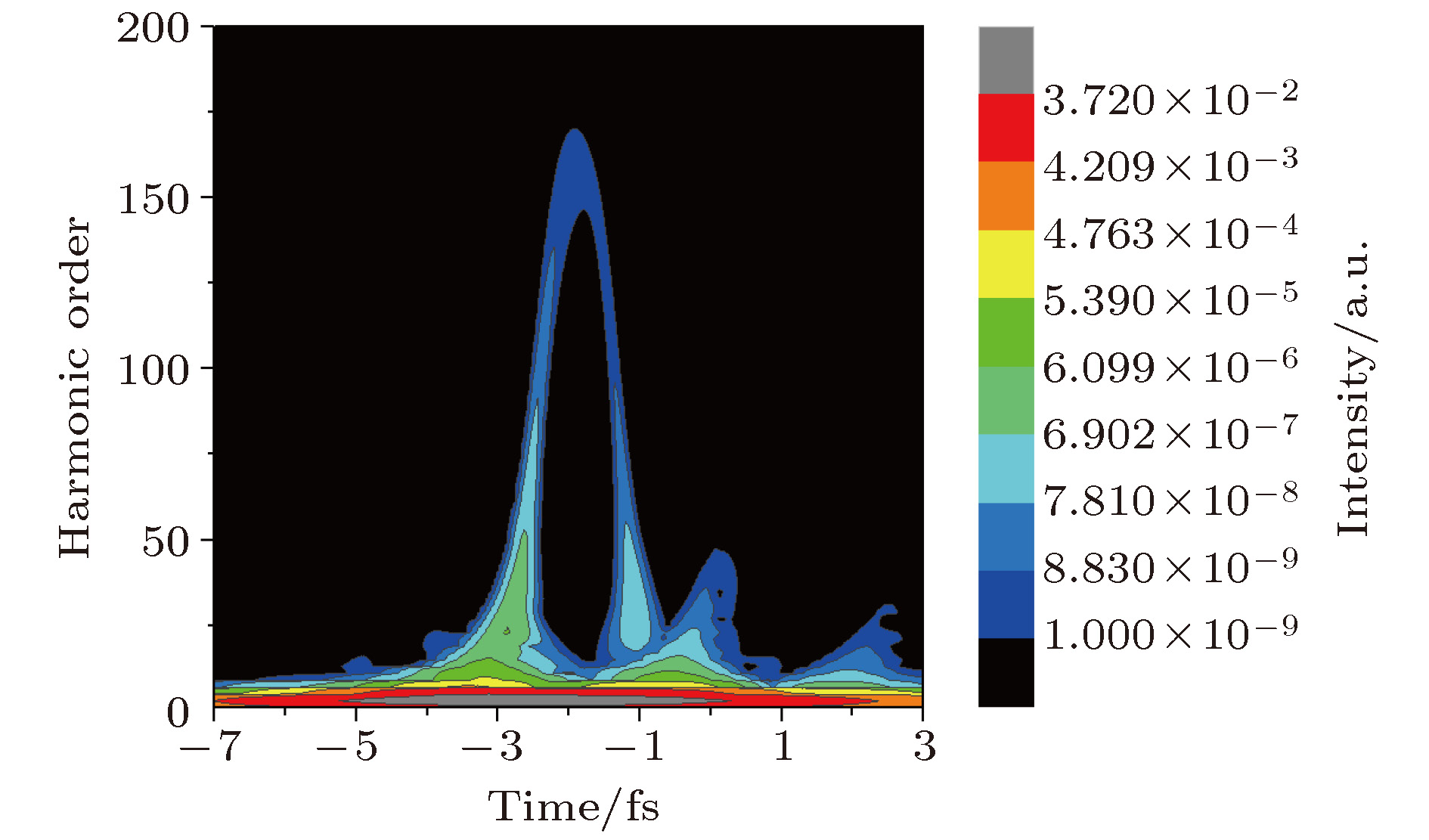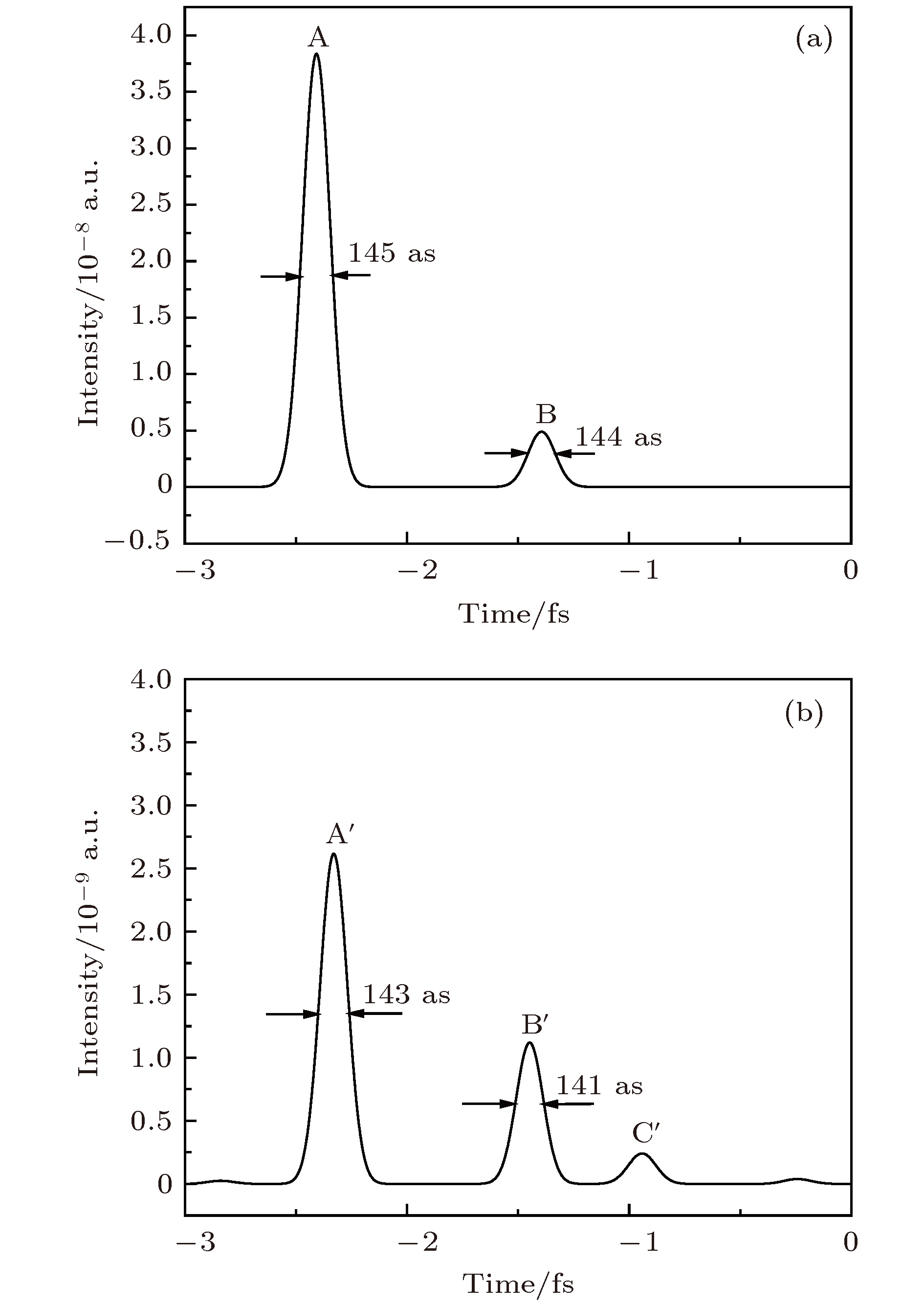-
利用强场近似理论开展了基于正交偏振场的双光学控制脉冲与氦原子相互作用产生高次谐波和阿秒脉冲发射的理论研究. 这里的正交偏振场由具有一定时间延迟、振幅相等且呈正交偏振的两束线偏振脉冲构成, 双光学控制脉冲是在正交偏振场的驱动脉冲电场方向附加一束线偏振二次谐波脉冲. 研究发现, 若合理地调整正交偏振场中两束线偏振脉冲之间的时间延迟及附加二次谐波场与驱动脉冲电场之间的相对相位, 可得到效率较高且在整个平台区及截止位置附近皆连续的高次谐波发射谱, 傅里叶变换后实现了143 as孤立短脉冲的辐射. 相比于利用两束反旋圆偏振脉冲附加二次谐波场的双光学控制方案, 该方案不仅克服了对入射驱动脉冲脉宽和强度的限制, 而且避免了偏振门前端光学周期引起的气体介质电离不利于谐波相位匹配的弊端.Isolated attosecond pulses make it possible to study and control the ultrafast electron processes in atoms and molecules. High order harmonic generation (HHG) is the most promising way to generate such pulses, benefiting from the broad plateau structure of the typical HHG spectrum. In previous HHG studies on the polarization gating scheme, atomic ionization caused by the laser cycles before the polarization gate not only places a limit on the pulse width and intensity of the driving laser, but also affects the phase matching of harmonics generated in a polarization gate. According to these, in this paper we propose a new double optical gating scheme, in which the polarization of the laser pulse changes from linear to elliptical and back to linear again. Thus, only the linearly polarized field in the leading of the pulse contributes to high harmonic generation. By using a strong field approximation theory, we first simulate high order harmonic and attosecond pulse generation from helium atom irradiated by a double optical gating pulse based on the orthogonal polarization field. Here the orthogonal polarization field consists of two linearly polarized pulses with a certain time delay, orthogonal polarization directions and equal amplitudes. And for the double optical gating pulse, the second harmonic of the driving field is added to an orthogonal polarization field with an appropriate phase and energy. It is found that the high harmonic spectrum with higher efficiency and supercontinuum plateau is obtained by reasonably adjusting the parameters of the combined pulse. After inverse Fourier transform, an isolated 143-as pulse with higher intensity can be realized by superposing supercontinuum harmonics from the 50th to the 150th order. Compared with the double optical gating scheme proposed by Chang et al. (Zhao K, Zhang Q, Chini M, Wu Y, Wang X, Chang Z 2012 Opt. Lett. 37 3891), our scheme not only overcomes the limit on the pulse duration and intensity of the incident pulse laser, but also avoids the harmonic phase mismatching in the process of the propagation due to unwanted ionization of the gas target caused by the laser cycles before the polarization gate.
-
Keywords:
- high order harmonic generation /
- attosecond pulse /
- orthogonal polarization gating field /
- double optical gating scheme
[1] Corkum P B, Krausz F 2007 Nat. Phys. 3 381
 Google Scholar
Google Scholar
[2] Drescher M, Hentschel M, Kienberger R, et al. 2002 Nature 419 803
 Google Scholar
Google Scholar
[3] Uiberacker M, Uphues Th, Schultze M, et al. 2007 Nature 446 627
 Google Scholar
Google Scholar
[4] Brabec T, Krausz F 2000 Rev. Mod. Phys. 72 545
 Google Scholar
Google Scholar
[5] Krausz F, Ivanov M 2009 Rev. Mod. Phys. 81 163
 Google Scholar
Google Scholar
[6] Drescher M, Hentschel M, Kienberger R, et al. 2001 Science 291 1923
 Google Scholar
Google Scholar
[7] Krause J L, Schafer K J, Kulander K C 1992 Phys. Rev. Lett. 68 3535
 Google Scholar
Google Scholar
[8] Schafer K J, Yang B, DiMauro L F, Kulander K C 1993 Phys. Rev. Lett. 70 1599
 Google Scholar
Google Scholar
[9] Ferrari F, Calegari F, Lucchini M, Vozzi C, Stagira S, Sansone G, Nisoli M 2010 Nat. Photon. 4 875
 Google Scholar
Google Scholar
[10] Goulielmakis E, Schultze M, Hofstetter M, et al. 2008 Science 320 1614
 Google Scholar
Google Scholar
[11] Lan P, Lu P, Cao W, Li Y H, Wang X L 2007 Phys. Rev. A 76 21801
 Google Scholar
Google Scholar
[12] Corkum P B, Burnett N H, Ivanov M Y 1994 Opt. Lett. 19 1870
 Google Scholar
Google Scholar
[13] Li J, Ren X, Yin Y, Zhao K, Chew A, Cheng Y, Cunningham E, Wang Y, Hu S, Wu Y, Chini M, Chang Z 2017 Nat. Commun. 8 794
 Google Scholar
Google Scholar
[14] Sansone G, Benedetti E, Calegari F, et al. 2006 Science 314 443
 Google Scholar
Google Scholar
[15] Vincenti H, Quéré F 2012 Phys. Rev. Lett. 108 113904
 Google Scholar
Google Scholar
[16] Thomas P, Lukas G, Mark J, Daniel M, Stephen R 2006 Opt. Lett. 31 975
 Google Scholar
Google Scholar
[17] Hiroki M, Steve G, Li C Q, Sabih D K, Mahendra M S, Eric M, Chang Z H 2008 Phys. Rev. Lett. 100 103906
 Google Scholar
Google Scholar
[18] Gaumnitz T, Jain A, Pertot Y, Huppert M, Jordan I, Ardana-Lamas F, Wörner H J 2017 Opt. Express 25 27506
 Google Scholar
Google Scholar
[19] Sola I J, Mevel E, Elouga L, et al. 2006 Nat. Phys. 2 319
 Google Scholar
Google Scholar
[20] Zhao K, Zhang Q, Chini M, Wu Y, Wang X W, Chang Z H 2012 Opt. Lett. 37 3891
 Google Scholar
Google Scholar
[21] Cao W, Lu P, Lan P, Wang X, Yang G 2006 Phys. Rev. A 74 063821
 Google Scholar
Google Scholar
[22] Bouhal A, Saliéres P, Breger P, Agostini P, Hamoniaux G, Mysyrowicz A, Antonietti A, Costantinescu R, Muller H G 1998 Phys. Rev. A 58 389
 Google Scholar
Google Scholar
[23] Pfeifer T, Jullien A, Abel M J, Nagel P M, Gallmann L, Neumark D M, Leone S R 2007 Opt. Express 15 17120
 Google Scholar
Google Scholar
[24] Jullien A, Pfeifer T, Abel M J, Nagel P M, Bell M J, Neumark D M, Leone S R 2008 Appl. Phys. B 93 433
 Google Scholar
Google Scholar
[25] Keldysh L V 1964 Zh. Eksp. Teor. Fiz. 47 1945
[26] Faisal F H M 1973 J. Phys. B 6 L89
[27] Reiss H R 1980 Phys. Rev. A 22 1786
 Google Scholar
Google Scholar
[28] Chang Z 2004 Phys. Rev. A 70 043802
 Google Scholar
Google Scholar
[29] Lewenstein M, Salieres P, L’Huillier A 1995 Phys. Rev. A 52 4747
 Google Scholar
Google Scholar
[30] Ammosov M V, Delone N B, Krainov V 1986 Zh. Eksp. Teor. Fiz. 91 2008
-
图 1 (a)驱动脉冲电场中未加二次谐波场、(b)加入二次谐波场情况下, 偏振控制脉冲总电场(红色曲线)、控制(绿色曲线)及驱动脉冲电场(黑色曲线)随时间变化三维图; (c)未加入二次谐波场、(d)加入二次谐波场情况下, 驱动脉冲电场光强随时间变化曲线图
Fig. 1. Three-dimensional diagrams for the total electric field (red line), gating field (black line) and driving field (green line) in polarization gating pulse as a function of time: (a) Orthogonal polarization field; (b) double optical gating field. The change of laser intensity in x-polarized direction with time: (c) Orthogonal polarization field; (d) double optical gating field.
图 2 脉宽为4 fs的偏振控制脉冲激光与氦原子相互作用得到的高次谐波发射谱, 其中红线对应于双光学控制方案, 黑线对应于正交偏振控制方案
Fig. 2. High order harmonic generation from helium atom irradiated by the polarization gating pulse with 4 fs pulse width. Red line corresponds to the double optical gating scheme; black line corresponds to the orthogonal polarization gating scheme.
图 3 (a)双光学控制方案、(b)正交偏振控制方案下, x方向驱动脉冲电场(黑色)、y方向控制脉冲电场(红色)及氦原子电离速率(蓝色填充区域)随时间的变化; (c)双光学控制方案、(d)正交偏振控制方案下, 高次谐波次数随电离(黑色点线)和复合时刻(红色点线)的变化
Fig. 3. Variations of the amplitude of x-polarized (black curve) and y-polarized field (red curve), and the ionization rate of the helium atom (filled blue region) with time: (a) Double optical gating scheme; (b) orthogonal polarization gating scheme. Evolution of the harmonics with ionization (black) and recombination (red) time in the x polarized field case: (c) Double optical gating scheme; (d) orthogonal polarization gating scheme.
-
[1] Corkum P B, Krausz F 2007 Nat. Phys. 3 381
 Google Scholar
Google Scholar
[2] Drescher M, Hentschel M, Kienberger R, et al. 2002 Nature 419 803
 Google Scholar
Google Scholar
[3] Uiberacker M, Uphues Th, Schultze M, et al. 2007 Nature 446 627
 Google Scholar
Google Scholar
[4] Brabec T, Krausz F 2000 Rev. Mod. Phys. 72 545
 Google Scholar
Google Scholar
[5] Krausz F, Ivanov M 2009 Rev. Mod. Phys. 81 163
 Google Scholar
Google Scholar
[6] Drescher M, Hentschel M, Kienberger R, et al. 2001 Science 291 1923
 Google Scholar
Google Scholar
[7] Krause J L, Schafer K J, Kulander K C 1992 Phys. Rev. Lett. 68 3535
 Google Scholar
Google Scholar
[8] Schafer K J, Yang B, DiMauro L F, Kulander K C 1993 Phys. Rev. Lett. 70 1599
 Google Scholar
Google Scholar
[9] Ferrari F, Calegari F, Lucchini M, Vozzi C, Stagira S, Sansone G, Nisoli M 2010 Nat. Photon. 4 875
 Google Scholar
Google Scholar
[10] Goulielmakis E, Schultze M, Hofstetter M, et al. 2008 Science 320 1614
 Google Scholar
Google Scholar
[11] Lan P, Lu P, Cao W, Li Y H, Wang X L 2007 Phys. Rev. A 76 21801
 Google Scholar
Google Scholar
[12] Corkum P B, Burnett N H, Ivanov M Y 1994 Opt. Lett. 19 1870
 Google Scholar
Google Scholar
[13] Li J, Ren X, Yin Y, Zhao K, Chew A, Cheng Y, Cunningham E, Wang Y, Hu S, Wu Y, Chini M, Chang Z 2017 Nat. Commun. 8 794
 Google Scholar
Google Scholar
[14] Sansone G, Benedetti E, Calegari F, et al. 2006 Science 314 443
 Google Scholar
Google Scholar
[15] Vincenti H, Quéré F 2012 Phys. Rev. Lett. 108 113904
 Google Scholar
Google Scholar
[16] Thomas P, Lukas G, Mark J, Daniel M, Stephen R 2006 Opt. Lett. 31 975
 Google Scholar
Google Scholar
[17] Hiroki M, Steve G, Li C Q, Sabih D K, Mahendra M S, Eric M, Chang Z H 2008 Phys. Rev. Lett. 100 103906
 Google Scholar
Google Scholar
[18] Gaumnitz T, Jain A, Pertot Y, Huppert M, Jordan I, Ardana-Lamas F, Wörner H J 2017 Opt. Express 25 27506
 Google Scholar
Google Scholar
[19] Sola I J, Mevel E, Elouga L, et al. 2006 Nat. Phys. 2 319
 Google Scholar
Google Scholar
[20] Zhao K, Zhang Q, Chini M, Wu Y, Wang X W, Chang Z H 2012 Opt. Lett. 37 3891
 Google Scholar
Google Scholar
[21] Cao W, Lu P, Lan P, Wang X, Yang G 2006 Phys. Rev. A 74 063821
 Google Scholar
Google Scholar
[22] Bouhal A, Saliéres P, Breger P, Agostini P, Hamoniaux G, Mysyrowicz A, Antonietti A, Costantinescu R, Muller H G 1998 Phys. Rev. A 58 389
 Google Scholar
Google Scholar
[23] Pfeifer T, Jullien A, Abel M J, Nagel P M, Gallmann L, Neumark D M, Leone S R 2007 Opt. Express 15 17120
 Google Scholar
Google Scholar
[24] Jullien A, Pfeifer T, Abel M J, Nagel P M, Bell M J, Neumark D M, Leone S R 2008 Appl. Phys. B 93 433
 Google Scholar
Google Scholar
[25] Keldysh L V 1964 Zh. Eksp. Teor. Fiz. 47 1945
[26] Faisal F H M 1973 J. Phys. B 6 L89
[27] Reiss H R 1980 Phys. Rev. A 22 1786
 Google Scholar
Google Scholar
[28] Chang Z 2004 Phys. Rev. A 70 043802
 Google Scholar
Google Scholar
[29] Lewenstein M, Salieres P, L’Huillier A 1995 Phys. Rev. A 52 4747
 Google Scholar
Google Scholar
[30] Ammosov M V, Delone N B, Krainov V 1986 Zh. Eksp. Teor. Fiz. 91 2008
计量
- 文章访问数: 14228
- PDF下载量: 143
- 被引次数: 0














 下载:
下载:





